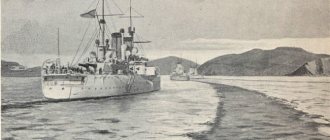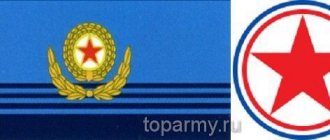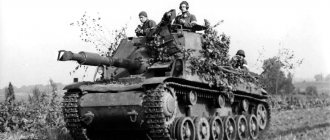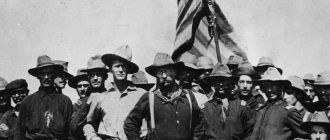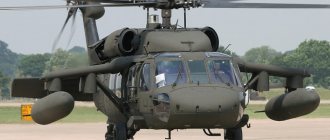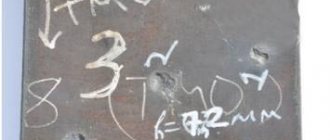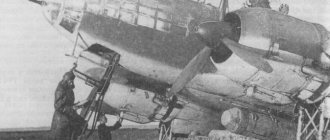Black Tuesday for the US Air Force (Korean War 1951)
After Soviet jet fighters appeared in the skies of Korea and began to participate in air battles, the situation in Korea changed significantly. The very first battle against American B-29 bombers, called “Superfortresses,” showed that this was just a name. The US Air Force command was forced to admit that their bombers were very vulnerable and noted the effectiveness of the 23 and 37 mm guns that were armed with the MiG-15 fighters. Just a few shells hitting the bomber could destroy it. The meeting of the B-29 with Soviet fighters was lethal for the latter, and the losses from such battles were quite noticeable for the United States, since each bomber cost a fortune. One should not discount the fact that with each plane its crew of 12 people often died, which was an even greater blow for the Americans. "Black Tuesday" for the US Air Force
“Black Tuesday” for American strategic aviation was the day of October 30, 1951, when the flying fortresses that took off to bomb the Korean airfield in Namsi suffered very heavy losses, and the raid ended in nothing. This defeat marked the complete collapse of the use of strategic aviation in the daytime. After this battle, the United States was forced to reconsider its views on the use of B-29 bombers in Korea.
On the American side, about 200 cover fighters of various types and 21 B-29 bombers took part in the raid. They were opposed by 56 MiG-15 fighters, which were located at the Miaogou and Andong airfields. 44 vehicles took part directly in the air battle, while another 12 were left in reserve to cover airfields in case the enemy broke through to them.
MiG-15
Considering that the barrier of F-86 fighters was late in leaving, as well as the unsuccessful formation of the covering forces themselves, the Soviet pilots did not allocate any special groups to engage the American fighters in battle. All available MiGs were aimed only at striking bombers. It was also decided that the fighters would not operate in large groups, but in a large number of pairs, which would be given independence in choosing targets - B-29. In fact, this allowed the MiG-15 to reach maximum speed, maneuver freely and act as proactively as possible.
American planes were intercepted on the approaches to Namsi. While the F-86 screen was searching for Soviet aircraft near the Yalu River, the fate of the air battle was virtually sealed. 22 pairs of Soviet fighters, in a rapid dive through the formation of American covering fighters at a speed of about 1000 km/h, attacked the strategic bombers, opening fire from 132 of their guns. The very first attack of the “Migs” became crushing. B-29, having not yet reached the target, losing falling and burning vehicles, quickly turned to the sea that saved them. Since the route of the “flying fortresses” was only 20-30 km. Some of the bombers managed to escape from the coastline, beyond which Soviet aircraft were prohibited from operating. According to the testimony of the navigator of one of the B-29s, who participated in this raid and was later captured, there were killed and wounded on all the planes that survived the attack by Soviet fighters.
At the same time, not a single bomb fell on the Namsi airfield on October 30. The American bombers turned around on the approaches to the airfield and fled. On the same flight, a reconnaissance aircraft was also shot down, which was supposed to confirm the results of the bombing with photographs. According to Soviet information, the Americans lost 12 B-29 bombers and 4 F-84 fighters in battle, many American aircraft were damaged, while the Soviet side lost only one MiG-15 in a battle with an F-86 already over the territory of the PRC, the border of which American planes violated.
B-29
In an effort to somehow justify their losses, after almost every air battle with Soviet MiGs, the Americans reported their high losses from B-29 fire. In fact, Soviet fighters practically did not suffer from the fire of the “superfortresses”. Moreover, the reason for this is not that it was impossible to shoot down the MiG-15 with 12.7 mm heavy machine gun fire. Soviet planes were shot down using the same machine guns mounted on American fighters and fighter-bombers. However, it was the confrontation between the B-29 and the MiG-15 that was always in favor of the latter for a number of reasons. The guns with which the MiGs were armed (37 and 23 mm caliber) had a significantly greater range of effective fire, as well as destructive power compared to the B-29 heavy machine guns. In addition, the B-29s had insufficient survivability. It is also worth noting the fact that the counting mechanisms and machine gun installations themselves, installed on the bombers, could not provide effective fire and aiming at aircraft that attacked at closing speeds of 150-160 m/s. The entire attack took no more than 3-4 seconds.
The results of Black Tuesday alarmed the top leadership of the US military and shocked the US Air Force command. A special commission arrived in Korea to investigate the circumstances of such a severe defeat. For 3 days, not a single American aircraft appeared in the coverage area of the Soviet MiGs. About a month later, the Americans decided, apparently, to test their conclusions about the possibility of daytime use of the B-29. A group of Soviet fighters intercepted 3 B-29 aircraft, which were covered by several dozen F-86s on the approach to the crossings at Aney. All bombers were shot down. After this, the Americans completely abandoned the use of B-29s in the daytime.
Mistakes made by Americans
The first was that the B-29 bombers, which were flying from the east coast to bypass the radar field of our radars located at Aneyu and Pyongyang, were accompanied by a large number of F-84 and F-86 fighters, which were flying at an altitude of about 8000 m. Soviet radars detected large groups of fighters at high altitudes 200-250 km away. to the goal. The nature of their flight was revealed by the bombers below, although the latter were not yet visible on the radar screens. American fighters were moving at a speed of about 720-800 km/h along a zigzag course with a clearly visible route axis. A measurement of the overall displacement speed of aircraft over the terrain demonstrated that it was 400-420 km/h. After that everything became completely clear. The information received coincided with the cruising speed of the “superfortresses”. The correct conclusions were drawn that a group of B-29 bombers was being sent from the east coast of Korea, which were covered by a large group of fighters.
The second mistake made by the American was that the time the barrier was released from the F-86 Saber fighters was calculated without taking into account the possibility of the enemy detecting the B-29 and making a decision to take off the MiG-15 fighters to intercept. At that moment, when the F-86 and F-84 fighters were heading at maximum speed to the Andong River area in order to attack the Soviet fighters on takeoff and climb, the MiGs were already in the air. Using fuel from external tanks, they were already approaching the strike group of “superfortresses”. The Soviet side listened to the radio communications of American crews, which made it possible to find out that the operating fighters had the call signs “Malinovka” and “Sinitsa”, which belonged to two different fighter wings. The joint actions of the F-86 and F-84 of two different formations suggested that the Americans were planning a raid on some important facility located in close proximity to the MiG’s home base. The location of the impact was determined precisely.
It is worth noting that the Americans reacted quite sharply and quickly to all attempts to build new or repair destroyed airfields on the territory of the DPRK. Their opposition in this regard was very thoughtful and rational from a military point of view. The Americans conducted constant aerial reconnaissance of such objects and launched their bombing attacks immediately at the moment of completion of restoration work or construction. In this way they saved the strength of their bombers, while achieving the greatest effectiveness of strikes. On the eve of October 30, 1951, the Americans carried out intensive reconnaissance of the construction of the new Namsi airfield, which was moving toward completion. The flight axis of the strike group of bombers and other available indirect data made it possible to reveal the target of the raid, which was the Namsi airfield.
The third serious miscalculation made by the American side was that the escort fighters were concentrated in fairly dense groups in close proximity to the B-29. At the same time, they flew at fairly low speeds. All this allowed the Soviet “Migs” to reach advantageous positions for an attack and carry it out, without any significant opposition from the enemy.
Soviet presence in Korea
The 64th Fighter Air Corps of the USSR Air Force took part in the fighting in North Korea in 1950-1953. The corps included all Soviet flight and anti-aircraft units that were concentrated on this theater of operations. The USSR's participation in the war was secret, so pilots were forbidden to fly over the sea and approach the front line. All aircraft had Chinese markings, and the pilots were issued Chinese documents and military uniforms. Initially, pilots were even required not to speak Russian during combat missions. The pilots learned the Korean phrases they needed in battle, but already during the first battles this requirement had to be abandoned, since it turned out to be practically impossible to fulfill. The fact of the participation of Soviet pilots in the war was made public in the USSR only in the 1970s and 80s, while at the same time the UN aviation pilots understood perfectly well who they had to fight against in the air.
The main task of the corps was to cover the Suphung hydroelectric power station, as well as bridges on the Yalu River in the border zone between China and Korea, as well as economic and military facilities on the territory of the DPRK, rear communications of Korean and Chinese troops. In addition, Soviet pilots participated in training pilots for the Air Forces of the People's Republic of China and the DPRK.
According to the memoirs of retired Aviation Major General Semyon Kramarenko, a participant in the fighting in Korea, Hero of the Soviet Union, Korean and Chinese pilots could not resist the Yankees on their own; they did not have enough experience. They fought quite courageously, but in a month it was impossible to train a real fighter pilot from a peasant boy who did not know Russian. The Americans, meanwhile, had numerical superiority and the latest technology, behaved aggressively, even impudently, and fought competently. Without our help, events in this region of the world could have taken a completely different turn.
F-86 Saber and MiG-15
Semyon Kramarenko highly praised the level of training of American pilots, emphasizing that their behavior in battle could hardly be called knightly. Often American pilots shot ejected pilots in the air. At the same time, Soviet pilots did not behave this way. In December 1951, a group of fighters, which included Kramarenko, defeated an Australian squadron in Gloster Meteors; out of 16 aircraft, only 4 were able to escape. Kramarenko shot down two Glosters and could have caught up and lit the third, but did not, seeing that the pilot of the Gloucester was a young guy, he felt sorry for him. He decided that he had better return to the base and tell his people how they were “warmly” greeted here. According to Semyon Kramarenko, it would be quite appropriate to say that Soviet pilots fought only with those who wanted to fight. The MiG-15s were painted silver, which was visible from many kilometers away in the sun. This allowed the enemy to evade air combat in advance.
During their time in the conflict from November 1950 to July 1953, 64th Corps pilots flew approximately 64,000 combat missions. Conducted 1872 air battles. The corps shot down 1,250 enemy aircraft. Anti-aircraft artillery accounted for 150 aircraft, and 1,100 fighter groups. The corps' own losses amounted to 335 aircraft. At least 120 Soviet pilots and 68 anti-aircraft gunners were killed in Korea.
Sources used: www.airforce.ru/history/korea/chapter2.htm www.ug.ru/archive/1296 www.flowair-aviation.com/mig15_ch.html Materials from the free Internet encyclopedia "Wikipedia".
Why was Ivan Kozhedub banned from flying?
From March 1951 to February 1952, the 64th Air Corps included the 324th Fighter Aviation Svir Red Banner Division. The formation was commanded at this time by one of the two most successful Soviet aces - three times Hero of the Soviet Union, Colonel Ivan Kozhedub. The initiator of his sending to China, to the border with North Korea, according to the widespread version, was Vasily Stalin, the commander of the Air Force of the Moscow Military District, which included the 324th Air Division. By his order, he categorically forbade Ivan Kozhedub to take to the air and participate in air battles while on a business trip: if such a famous ace fell into the hands of the Americans, it would become a major political and ideological disaster. Moreover, Ivan Kozhedub even went on a business trip under someone else’s name - Krylov. Although it was no secret to his subordinates who exactly commanded the air division, which became the most effective of all Soviet formations that fought in the Korean skies: 216 victories with its own losses of 27 aircraft and nine pilots.
Lieutenant Colonel Ivan Kozhedub on the eve of departure to Korea with a Chinese comrade, 1950
Source: wwii.space
Why are our aces better than American ones?
The Korean War was also the first military conflict in which ace jet pilots appeared. Of course, they were far from the performance of the pilots of the Second World War, whose personal account exceeded fifty enemy aircraft, like, for example, the same Colonel Ivan Kozhedub (64 victories), and sometimes reached several hundred - like the German ace Erich Hartmann, winning 352 victories, which is an absolute record in history. But both Soviet and American pilots had a personal count of 10 or more enemy vehicles. Moreover, the victory “on points” remains with the USSR pilots: the most victories were won by Captain Nikolai Sutyagin, who chalked up 22 confirmed downed aircraft and one unconfirmed one, and Lieutenant Colonel Evgeny Pepelyaev, whose personal score was 20 aircraft. At the same time, the most successful American ace pilot, Joseph McConnell, managed to shoot down 16 enemy aircraft. In total, Soviet pilots destroyed, according to our data, 1,106 enemy aircraft during the Korean War, and the Americans, according to their data (which many researchers admit to be at least twice as high), only 827 Soviet MiG-15s.
Hero of the Soviet Union Guard Captain Sergei Kramarenko, who shot down 13 American aircraft over Korea, in the cockpit of his MiG-15 fighter
Source: redstar.ru
The last heroes of the piston era...
The Korean War was the last major military conflict in which piston aircraft, the kings of the skies of World War II, took a massive part. Until the fall of 1950, the North Korean Air Force had only piston aircraft: Soviet Yak-3, Yak-7, Yak-9 and La-7 fighters and Il-10 attack aircraft. The Chinese Volunteer Corps used Tu-2 bombers and Po-2 biplanes as light night bombers, and a small number of Soviet pilots from the 64th Air Corps flew La-11 fighters. On the American side, veterans fought who had proven themselves during battles over the Pacific Ocean: for example, F4U Corsair carrier-based fighters, A-1 Skyrider and A-26 Invader attack aircraft, and until the end of the conflict, the role of heavy bombers was performed exclusively by B -29 "Superfortress".
North Korean pilots from the 887th Air Regiment are briefed on the tarmac next to a Soviet La-11 fighter with North Korean Air Force insignia, 1950-52
Source: arsenal-info.ru

